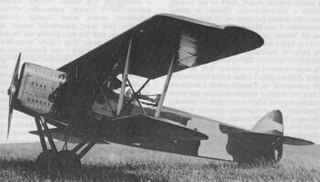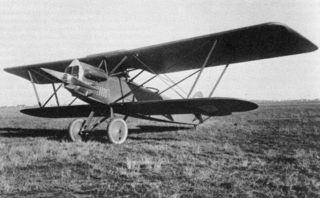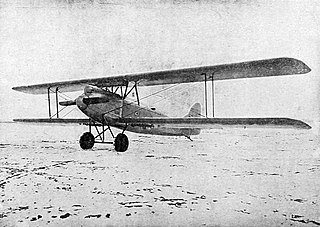
The Aero A.11 was a biplane light bomber and reconnaissance aircraft built in Czechoslovakia between the First and Second World Wars. It formed the basis for many other Czechoslovakian military aircraft of the inter-war period. Around 250 were built, with some remaining in service at the outbreak of World War II.

The Aero A.12 was a Czechoslovakian biplane light bomber and military reconnaissance aircraft manufactured in small numbers shortly after World War I. Although reminiscent of the Hansa-Brandenburg-designed aircraft that Aero was building during the war under licence as the Ae.10, the A.12 was the company's own design. It is perhaps most significant as the direct descendant of the highly successful A.11 and its various derivatives. An example of the type is preserved at the Letecké Muzeum in Kbely.
The Aero A.25 was a biplane military trainer aircraft developed in Czechoslovakia from the Aero A.11 reconnaissance-bomber and generally similar to the Aero A.21 night trainer.

The Aero A.29 was a military biplane developed in Czechoslovakia from the ubiquitous Aero A.11 reconnaissance-bomber. Aero equipped it with floats and it served as a target tug for training anti-aircraft gunners.
The Aero A.22 was a Czechoslovakian biplane civil utility aircraft based on the Aero A.12 reconnaissance-bomber. The observer's position was replaced by seating for two passengers.
The Aero A-24 was a twin-engined biplane bomber aircraft of the 1920s. Flight tests showed it to be severely underpowered, making it useless as a combat aircraft. Only a single prototype was built.
The Aero A.26 was a Czechoslovakian military reconnaissance biplane aircraft built by Aero Vodochody in the 1920s. It was Aero's last design to be based on the Hansa-Brandenburg B.I aircraft that the company had been building under licence during World War I as the Ae.10.

The Aero A.30 was a biplane light bomber and reconnaissance aircraft built in Czechoslovakia in the late 1920s. It originated as an attempt by Aero to improve the performance of the Aero A.11, but soon evolved into quite a different aircraft, larger and more powerful than its predecessor. The aircraft is readily distinguished from other related types by the difference in spans between its wings – the upper set being of much greater span than the lower.

The Aero A.32 was a biplane built in Czechoslovakia in the late 1920s for army co-operation duties including reconnaissance and tactical bombing. While the design took the Aero A.11 as its starting point, the aircraft incorporated significant changes to make it suited for its new low-level role.

The Aero A.34 Kos was a small sports and touring biplane built in Czechoslovakia in the 1930s.

The Aero A.35 was a Czechoslovakian airliner of the 1920s and 1930s. Designed by Aero for long-range flight, with a transatlantic crossing in mind, it saw service with CSA although no such crossing was ever attempted. A conventional high-wing monoplane, it was a very modern design for its day in all but one respect – the cockpit still had open sides. An extra passenger could also be accommodated here, beside the pilot.
The Aero A.104 was a parasol monoplane light bomber and reconnaissance aircraft built in Czechoslovakia during the 1930s. It was the final derivative of the Aero A.100, and was essentially an Aero Ab.101 with an enclosed cockpit and without the lower wing. Although two different prototypes flew in 1937, it was not mass-produced.

The Aero A.200 was a sportsplane of Czechoslovakia, designed and built specifically to compete in Challenge 1934, the European touring plane championships. It was a four-seater low-wing monoplane.

The Aero A.304 was a Czechoslovakian bomber aircraft that first flew in 1937. It had originally been developed as an airliner, the A.204, but when Aero could not find buyers for the design, it was militarised and successfully marketed to the Czechoslovak Air Force. It was also exported to Bulgaria, where it was known as the "Pelikan".

The Aero L-60 Brigadýr was a small, high-wing propeller-driven Czechoslovakian STOL utility aircraft developed for both civil and military use. A prototype, designated XL-60, with Argus As 10C engine, first flew on December 24, 1953, but it was not successful. The plane was thoroughly redesigned and the second improved prototype, with M-208B flat-six engine, flew on June 8, 1954. The aircraft's configuration bears a strong resemblance to the Fieseler Fi 156 "Storch" licence-produced in Czechoslovakia during and after World War II, and which this aircraft was intended to replace. By the end of production in 1960, 273 had been built by Aero, including an improved version, the L-160 with an all-metal tail.

The Schempp-Hirth Discus is a Standard Class glider designed by Schempp-Hirth. It was produced in Germany between 1984 and 1995 but has continued in production in the Czech Republic. It replaced the Standard Cirrus. It was designed by Klaus Holighaus.

The Letov Š-6 was a bomber aircraft produced in Czechoslovakia during the 1920s. Derived from the Š-2, it was a biplane of conventional design. The wing cellule was an all-new design with a thicker profile, and while it had been intended to build them with a metal structure, wood was used instead due to shortages. Performance during testing was so promising that in 1924 an Š-6 was used to set a new altitude record with a 500 kg payload, and a national endurance record of 10 h 32 min.

The Letov Š-8 was a Czech racing aircraft designed by Alois Šmolik. The aircraft was wooden-built, mostly fabric covered, with tail-skid undercarriage and was powered by a Napier Lion engine.
The Bagalini Colombo is an Italian homebuilt aircraft that was designed by Marino Bagalini. The aircraft is supplied in the form of plans for amateur construction.

The Historical Ryan STA was an American homebuilt aircraft that was designed and produced by the Historical Aircraft Corporation of Nucla, Colorado. The aircraft was an 85% scale replica of the original Ryan STA and when it was available was supplied as a kit for amateur construction.













